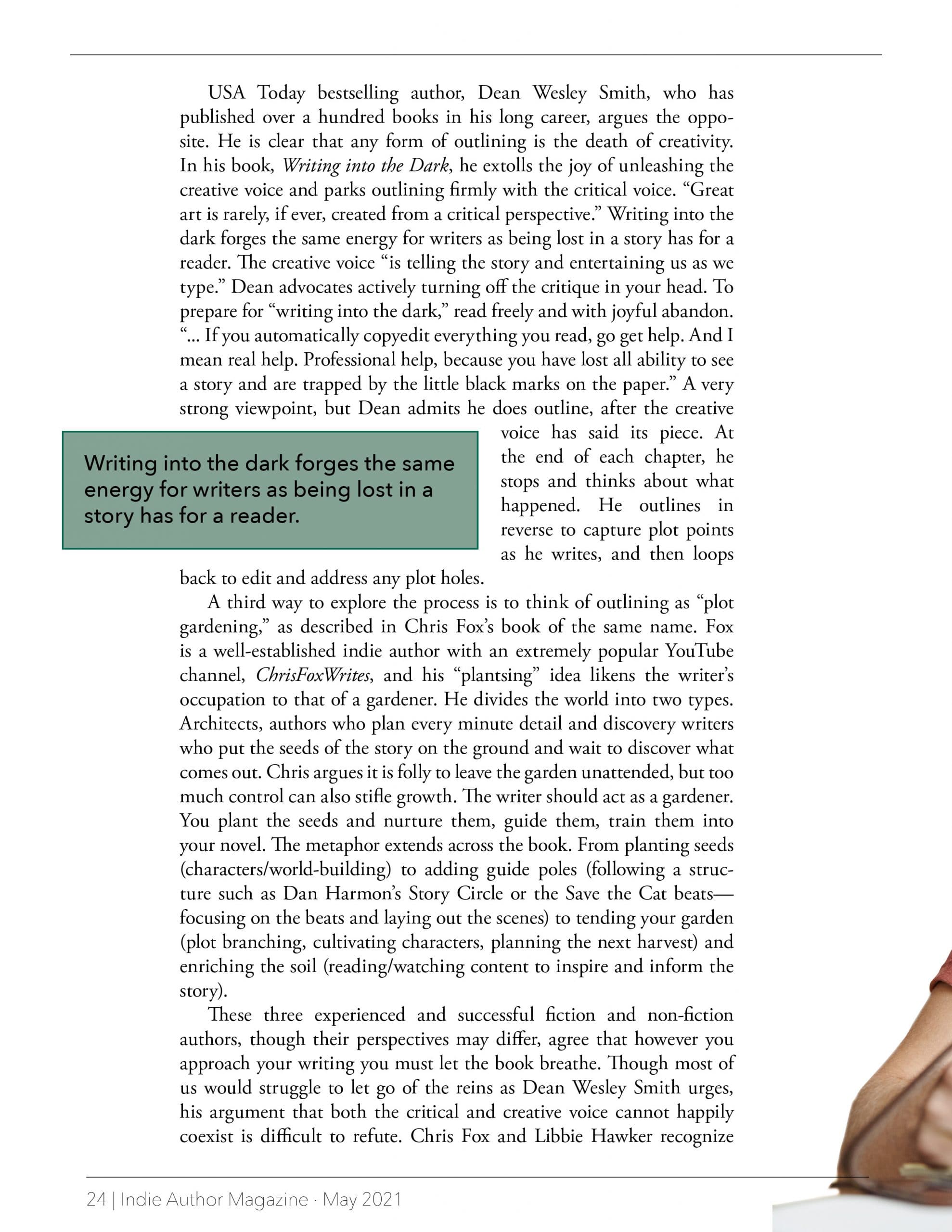If you stand at the front of a conference room full of authors and ask for a show of hands who are “pantsers” and who are “plotters,” you would start a literary battle, possibly literally. Feelings run high in both camps. The question for any indie author is, will one method prove to be more efficient for me than the other?
Indie authors trade in words already written. There is no publisher’s advance to fill the fridge and stock your cupboards. The key to success is to get your story out there as quickly as possible. If there is a way to ensure optimum efficiency whilst maintaining quality control that allows you enough creative freedom to keep the artist inside sated, then surely that’s the winning ticket. Many successful authors cite outlining as the cleverest way forward.
Before looking at what outlining is and how it potentially is a meeting point between the two styles, let’s explore what we mean by pantsing and plotting. Pantsers, a.k.a. discovery writers, say that they do not plan their writing in advance; they prefer to let the story unfold. Plotters, on the other hand, cannot put pen to paper, finger to keyboard, or even voice to dictaphone without knowing all the details of their story before they begin.
Indie author, Libbie Hawker, in her influential work Take Off Your Pants!, describes pantsing as “flying by the seat of your pants; going with the flow.” She is very clear that if she could habitually “pants” fast enough to support her career, she would “wear party hats all day long and do a happy-dance every time…” However, she states that “if your goals include quitting your day job… then effective outlining is a skill you must learn.”
She advocates a three-legged outline method that builds a Story Core, namely establishing three key aspects:
Character Arc
Theme and
Pacing
Hawker maintains that this approach differs from plotting every detail. For her, “plot is a sequence of events, the action that goes on outside of the character.” Though plot can form the additional leg to your stool and help to provide the structure of your story with greater strength and integrity, breaking things down into that level of detail is unnecessary if you have the other three legs in place. She argues she can outline a novel in half a day. Time well invested, as it allows you to write faster, with no dead ends, fewer plot holes and still provides the writer with the freedom to channel their muse.
USA Today bestselling author, Dean Wesley Smith, who has published over a hundred books in his long career, argues the opposite. He is clear that any form of outlining is the death of creativity. In his book, Writing into the Dark, he extolls the joy of unleashing the creative voice and parks outlining firmly with the critical voice. “Great art is rarely, if ever, created from a critical perspective.” Writing into the dark forges the same energy for writers as being lost in a story has for a reader. The creative voice “is telling the story and entertaining us as we type.” Dean advocates actively turning off the critique in your head. To prepare for “writing into the dark,” read freely and with joyful abandon. “… If you automatically copyedit everything you read, go get help. And I mean real help. Professional help, because you have lost all ability to see a story and are trapped by the little black marks on the paper.” A very strong viewpoint, but Dean admits he does outline, after the creative voice has said its piece. At the end of each chapter, he stops and thinks about what happened. He outlines in reverse to capture plot points as he writes, and then loops back to edit and address any plot holes.
A third way to explore the process is to think of outlining as “plot gardening,” as described in Chris Fox’s book of the same name. Fox is a well-established indie author with an extremely popular YouTube channel, ChrisFoxWrites, and his “plantsing” idea likens the writer’s occupation to that of a gardener. He divides the world into two types. Architects, authors who plan every minute detail and discovery writers who put the seeds of the story on the ground and wait to discover what comes out. Chris argues it is folly to leave the garden unattended, but too much control can also stifle growth. The writer should act as a gardener. You plant the seeds and nurture them, guide them, train them into your novel. The metaphor extends across the book. From planting seeds (characters/world-building) to adding guide poles (following a structure such as Dan Harmon’s Story Circle or the Save the Cat beats—focusing on the beats and laying out the scenes) to tending your garden (plot branching, cultivating characters, planning the next harvest) and enriching the soil (reading/watching content to inspire and inform the story).
These three experienced and successful fiction and non-fiction authors, though their perspectives may differ, agree that however you approach your writing you must let the book breathe. Though most of us would struggle to let go of the reins as Dean Wesley Smith urges, his argument that both the critical and creative voice cannot happily coexist is difficult to refute. Chris Fox and Libbie Hawker recognise this challenge, and their hybrid methods aim to harness the best of both worlds. Neither pure plotters nor pantsers, they use structures to provide a framework from which to write smarter.
For non-fiction books, arguably, there is an even greater need to harness the critical voice. You need to qualify your statements, prove your research, and arrange your chapters and subsections logically to scaffold the reader’s understanding. Outlining is not about over-analyzing or becoming paralysed in the detail. There are no hard and fast rules. If a structure helps you write faster, whilst still allowing your creative voice its freedom, then that’s the sweet spot. In their books, these writers explore their methods to manage and maintain the creative process with maximum business efficiency, but what works for them might not work for you.
Finding what works for you is the key, and there are many systems to choose from. Check out this comprehensive list of twelve outlining methods to help you find one that works for you. Alternatively, take a look at Prowriting Aid’s suggestions which show you can work equally well with old school index cards or modern-day programmes like Trello.
The title of this article is a play on Polonius’s words in Shakespeare’s Hamlet (Act I, Sc. III). The quote runs, “Neither a borrower nor a lender be…” Polonius warns of the need to avoid extremes and temper your decisions with the wisdom of the middle ground, but above all be honest with yourself. Outlining should help you write better books, faster. But if you rail against it and want to write free, then that’s what is best for you, and if you prefer more structure, detail every plotline in advance. But whatever you do, as Polonius says, “To thine ownself be true.”
References:
Take off your pants: Outline your books for faster, better writing, Libbie Hawker
Writing into the dark – How to write a novel without an outline, Dean Wesley Smith
Plot Gardening: Write faster, write smarter, Chris Fox
Useful websites:
https://thejohnfox.com/2020/01/12-great-ways-to-outline-a-novel/
https://prowritingaid.com/art/1417/ideas-to-outline-a-novel.aspx




